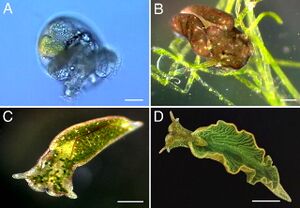Elysia chlorotica: Difference between revisions
No edit summary |
No edit summary |
||
| Line 1: | Line 1: | ||
==Introduction== | ==Introduction== | ||
<i>Elysia chlorotica</i> is a type of sea slug that can do photosynthesis. | <i>Elysia chlorotica</i> is a type of sea slug that can do photosynthesis. | ||
{{Speciesbox | |||
| genus = Elysia | |||
| species = chlorotica | |||
| status_system = iucn | |||
| status = NE <!-- IUCN Red List: Not evaluated (yet) --> | |||
| image = Elysia-chlorotica-body.jpg | |||
| image_caption = 進食黃藻中的綠葉海天牛 | |||
| authority = [[Augustus Addison Gould|Gould]], 1870 | |||
}} | |||
==Life cycle and Morphology== | ==Life cycle and Morphology== | ||
[[File:Elysia chlorotica stages.jpg|thumb|300px|right|Development stages of <i>Elysia chlorotica</i>]] | [[File:Elysia chlorotica stages.jpg|thumb|300px|right|Development stages of <i>Elysia chlorotica</i>]] | ||
Revision as of 02:46, 5 December 2021
Introduction
Elysia chlorotica is a type of sea slug that can do photosynthesis.
| name = Batrachochytrium dendrobatidis | image = | regnum = Fungi | divisio = Chytridiomycota | classis = Chytridiomycetes | ordo = Rhizophydiales | genus = Batrachochytrium | species = B. dendrobatidis | binomial = Batrachochytrium dendrobatidis | binomial_authority = Longcore et al. 1999
Life cycle and Morphology
Elysia chlorotica is small sized sea slug. The adult individual are around 3~5 centimeters long. An Elysia chlorotica has two stages of development: juvenile and adult stages, which can be distinguish by its morphology and coloring. During juvenile stage, newly hatched E. chlorotica are usually translucent brown, with few red spots on their bodies. This stage remains until the initial feeding on algae. The E. chlorotica obtains chloroplast from the algae, preserving in its special digestive tract. The presence of chloroplast gradually turns the body color into bright green, and lost red spots.Elysid refers to the adult slug’s leaf-like shape which is caused by two large lateral parapodia on either side of its body. This morphology is beneficial as both camouflage and allowing the slug to be more efficient at photosynthesis. Other members of this family are distinguished by their parapodia in addition to bright coloring.
Kleptoplasty
Kleptoplasty is a special symbiosis behavior that the chloroplast uptake by algal prey can remain temporarily function in the organism, which allows an animal doing photosynthesis like plants. A typical species in the clade Sacoglass
Feeding
Conclusion
References
Rumpho, M. E., J. M. Worful, J. Lee, K. Kannan, M. S. Tyler, D. Bhattacharya, A. Moustafa, and J. R. Manhart. 2008. “Horizontal Gene Transfer of the Algal Nuclear Gene PsbO to the Photosynthetic Sea Slug Elysia Chlorotica.” Proceedings of the National Academy of Sciences 105 (46): 17867–71. https://doi.org/10.1073/pnas.0804968105.
Edited by Hao Yang, student of Joan Slonczewski,2021,Kenyon College.

